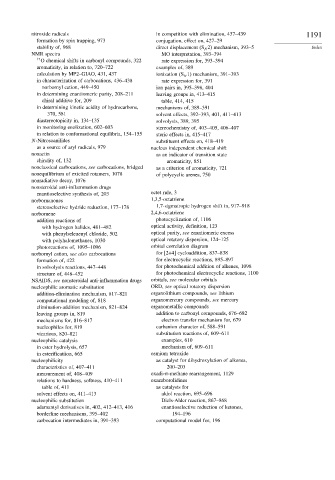Page 1204 - Advanced Organic Chemistry Part A - Structure and Mechanisms, 5th ed (2007) - Carey _ Sundberg
P. 1204
nitroxide radicals in competition with elimination, 437–439 1191
formation by spin trapping, 973 conjugation, effect on, 427–29
stability of, 968 direct displacement (S N 2) mechanism, 393–5 Index
NMR spectra MO interpretation, 393–394
17
O chemical shifts in carbonyl compounds, 322 rate expression for, 393–394
aromaticity, in relation to, 720–722 examples of, 389
calculation by MP2–GIAO, 431, 437 ionization (S N 1) mechanism, 391–393
in characterization of carbocations, 436–438 rate expression for, 391
norbornyl cation, 449–450 ion pairs in, 395–398, 404
in determining enantiomeric purity, 208–211 leaving groups in, 413–415
chiral additive for, 209 table, 414, 415
in determining kinetic acidity of hydrocarbons, mechanisms of, 389–391
370, 581 solvent effects, 392–393, 401, 411–413
diastereotopicity in, 134–135 solvolysis, 389, 395
in monitoring enolization, 602–603 stereochemistry of, 403–405, 406–407
in relation to conformational equilibria, 154–155 steric effects in, 415–417
N-Nitrosoanilides substituent effects on, 418–419
as a source of aryl radicals, 979 nucleus independent chemical shift
nonactin as an indicator of transition state
chirality of, 132 aromaticity, 851
nonclassical carbocations, see carbocations, bridged as a criterion of aromaticity, 721
nonequilibrium of exicited rotamers, 1078 of polycyclic arenes, 750
nonradiative decay, 1076
nonsteroidal anti-inflammation drugs
enantioselective synthesis of, 203 octet rule, 3
norbornanones 1,3,5-octatriene
stereoselective hydride reduction, 177–178 1,7-sigmatropic hydrogen shift in, 917–918
norbornene 2,4,6-octatriene
addition reactions of photocyclization of, 1106
with hydrogen halides, 481–482 optical activity, definition, 123
with phenylselenenyl chloride, 502 optical purity, see enantiomeric excess
with polyhalomethanes, 1030 optical rotatory dispersion, 124–125
photoreactions of, 1095–1096 orbital correlation diagram
norbornyl cation, see also carbocations for [2+4] cycloaddition, 837–838
formation of, 422 for electrocyclic reactions, 895–897
in solvolysis reactions, 447–448 for photochemical addition of alkenes, 1098
structure of, 448–452 for photochemical electrocyclic reactions, 1100
NSAIDS, see nonsteroidal anti-inflammation drugs orbitals, see molecular orbitals
nucleophilic aromatic substitution ORD, see optical rotatory dispersion
addition-elimination mechanism, 817–821 organolithium compounds, see lithium
computational modeling of, 818 organomercury compounds, see mercury
elimination-addition mechanism, 821–824 organometallic compounds
leaving groups in, 819 addition to carbonyl compounds, 676–682
mechanisms for, 816–817 electron transfer mechanism for, 679
nucleophiles for, 819 carbanion character of, 588–591
vicarious, 820–821 substitution reactions of, 609–611
nucleophilic catalysis examples, 610
in ester hydrolysis, 657 mechanism of, 609–611
in esterificatiion, 665 osmium tetroxide
nucleophilicity as catalyst for dihydroxylation of alkenes,
characteristics of, 407–411 200–203
measurement of, 408–409 oxadi- -methane rearrangement, 1129
relations to hardness, softness, 410–411 oxazaborolidines
table of, 411 as catalysts for
solvent effects on, 411–413 aldol reaction, 695–696
nucleophilic substitution Diels-Alder reaction, 867–868
adamantyl derivatives in, 402, 412–413, 416 enantioselective reduction of ketones,
borderline mechanisms, 395–402 194–196
carbocation intermediates in, 391–393 computational model for, 196

